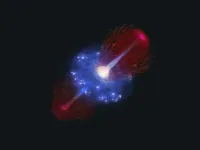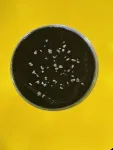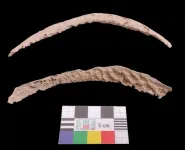(Press-News.org) Scientists have spotted a massive black hole in the early universe that is ‘napping’ after stuffing itself with too much food.
Like a bear gorging itself on salmon before hibernating for the winter, or a much-needed nap after Christmas dinner, this black hole has overeaten to the point that it is lying dormant in its host galaxy.
An international team of astronomers, led by the University of Cambridge, used the NASA/ESA/CSA James Webb Space Telescope to detect this black hole in the early universe, just 800 million years after the Big Bang.
The black hole is huge – 400 million times the mass of our Sun – making it one of the most massive black holes discovered by Webb at this point in the universe’s development. The black hole is so enormous that it makes up roughly 40% of the total mass of its host galaxy: in comparison, most black holes in the local universe are roughly 0.1% of their host galaxy mass.
However, despite its gigantic size, this black hole is eating, or accreting, the gas it needs to grow at a very low rate – about 100 times below its theoretical maximum limit – making it essentially dormant.
Such an over-massive black hole so early in the universe, but one that isn’t growing, challenges existing models of how black holes develop. However, the researchers say that the most likely scenario is that black holes go through short periods of ultra-fast growth, followed by long periods of dormancy. Their results are reported in the journal Nature.
When black holes are ‘napping’, they are far less luminous, making them more difficult to spot, even with highly-sensitive telescopes such as Webb. Black holes cannot be directly observed, but instead they are detected by the tell-tale glow of a swirling accretion disc, which forms near the black hole’s edges. The gas in the accretion disc becomes extremely hot and starts to glow and radiate energy in the ultraviolet range.
“Even though this black hole is dormant, its enormous size made it possible for us to detect,” said lead author Ignas Juodžbalis from Cambridge’s Kavli Institute for Cosmology. “Its dormant state allowed us to learn about the mass of the host galaxy as well. The early universe managed to produce some absolute monsters, even in relatively tiny galaxies.”
According to standard models, black holes form from the collapsed remnants of dead stars and accrete matter up to a predicted limit, known as the Eddington limit, where the pressure of radiation on matter overcomes the gravitational pull of the black hole. However, the sheer size of this black hole suggests that standard models may not adequately explain how these monsters form and grow.
“It’s possible that black holes are ‘born big’, which could explain why Webb has spotted huge black holes in the early universe,” said co-author Professor Roberto Maiolino, from the Kavli Institute and Cambridge’s Cavendish Laboratory. “But another possibility is they go through periods of hyperactivity, followed by long periods of dormancy.”
Working with colleagues from Italy, the Cambridge researchers conducted a range of computer simulations to model how this dormant black hole could have grown to such a massive size so early in the universe. They found that the most likely scenario is that black holes can exceed the Eddington limit for short periods, during which they grow very rapidly, followed by long periods of inactivity: the researchers say that black holes such as this one likely eat for five to ten million years, and sleep for about 100 million years.
“It sounds counterintuitive to explain a dormant black hole with periods of hyperactivity, but these short bursts allow it to grow quickly while spending most of its time napping,” said Maiolino.
Because the periods of dormancy are much longer than the periods of ultra-fast growth, it is in these periods that astronomers are most likely to detect black holes. “This was the first result I had as part of my PhD, and it took me a little while to appreciate just how remarkable it was,” said Juodžbalis. “It wasn’t until I started speaking with my colleagues on the theoretical side of astronomy that I was able to see the true significance of this black hole.”
Due to their low luminosities, dormant black holes are more challenging for astronomers to detect, but the researchers say this black hole is almost certainly the tip of a much larger iceberg, if black holes in the early universe spend most of their time in a dormant state.
“It’s likely that the vast majority of black holes out there are in this dormant state – I’m surprised we found this one, but I’m excited to think that there are so many more we could find,” said Maiolino.
The observations were obtained as part of the JWST Advanced Deep Extragalactic Survey (JADES). The research was supported in part by the European Research Council and the Science and Technology Facilities Council (STFC), part of UK Research and Innovation (UKRI).
END
Massive black hole in the early universe spotted taking a ‘nap’ after overeating
2024-12-18
ELSE PRESS RELEASES FROM THIS DATE:
Blight or benefit: how cellular neighbors shape the aging brain
2024-12-18
Much like plants in a thriving forest, certain cells in the brain create a nurturing environment, enhancing the health and resilience of their neighbors, while others promote stress and damage, akin to a noxious weed in an ecosystem.
A new study published in Nature on December 18, 2024, reveals these interactions playing out across the lifespan. It suggests local cellular interactions may profoundly influence brain aging — and offers fresh insights into how we might slow or even reverse the process.
“What was exciting to us was finding that some cells have a pro-aging effect on neighboring cells while others appear to have a rejuvenating effect on their neighbors,” ...
MIT engineers grow “high-rise” 3D chips
2024-12-18
The electronics industry is approaching a limit to the number of transistors that can be packed onto the surface of a computer chip. So, chip manufacturers are looking to build up rather than out.
Instead of squeezing ever-smaller transistors onto a single surface, the industry is aiming to stack multiple surfaces of transistors and semiconducting elements — akin to turning a ranch house into a high-rise. Such multilayered chips could handle exponentially more data and carry out many more complex functions than today’s electronics.
A significant hurdle, however, is the platform on which chips are built. Today, bulky ...
Physicists magnetize a material with light
2024-12-18
MIT physicists have created a new and long-lasting magnetic state in a material, using only light.
In a study that will appear in Nature, the researchers report using a terahertz laser — a light source that oscillates more than a trillion times per second — to directly stimulate atoms in an antiferromagnetic material. The laser’s oscillations are tuned to the natural vibrations among the material’s atoms, in a way that shifts the balance of atomic spins toward a new magnetic state.
The results provide a new way to control and switch antiferromagnetic materials, which are of interest for their potential ...
Unionization efforts by physicians between 2000 and 2024
2024-12-18
About The Study: Compared with 2000-2022, the number of union petitions with physicians in the bargaining units filed and certified increased in 2023 through May 2024. Organizing efforts were motivated by concerns about working conditions, physicians’ autonomy, and voice in management, and the quality of patient care.
Corresponding Author: To contact the corresponding author, Kevin Schulman, MD, email kevin.schulman@stanford.edu.
To access the embargoed study: Visit our For The Media website at ...
2024 update of the RECOVER-adult long COVID research index
2024-12-18
About The Study: The 2024 long COVID research index for adults builds on the 2023 index with additional data and symptoms to help researchers classify symptomatic long COVID and its symptom subtypes. Continued future refinement of the index will be needed as the understanding of long COVID evolves.
Corresponding Author: To contact the corresponding author, Leora I. Horwitz, MD, MHS, email leora.horwitz@nyulangone.org.
To access the embargoed study: Visit our For The Media website at this link https://media.jamanetwork.com/
(doi:10.1001/jama.2024.24184)
Editor’s Note: Please see the article for additional information, including ...
Building a backbone: scientists recreate the body’s ‘GPS system’ in the lab
2024-12-18
Scientists at the Francis Crick Institute have generated human stem cell models1 which, for the first time, contain notochord – a tissue in the developing embryo that acts like a navigation system, directing cells where to build the spine and nervous system (the trunk).
The work, published today in Nature, marks a significant step forward in our ability to study how the human body takes shape during early development.
The notochord, a rod-shaped tissue, is a crucial part of the scaffold of the developing body. ...
Syphilis had its roots in the Americas
2024-12-18
In spring 1495, the Italian campaign of Charles VIII of France was interrupted by an intense outbreak of an apparently unknown illness – a disease of high mortality that quickly engulfed the whole of Europe and left its survivors with life changing impairments to their bodies and minds. This documented epidemic is now interpreted to be the first historical account of syphilis.
The origin of syphilis is the subject of a decades-long debate. The late 15th century outbreak occurred shortly after the return of Columbus and his crew from their early expeditions to the Americas, which led some to believe that ...
Trajectory of cardiovascular health across childhood and adolescence
2024-12-18
About The Study: In this cohort of 1,500 children, across demographic subgroups, the trajectory of cardiovascular health (CVH) scores began to decline at approximately age 10, associated with health behaviors rather than health factors. Statistically significant (albeit small) differences in CVH trajectory parameters by sociodemographic characteristics were also identified. This study provides insight into the trajectory of CVH early in life, which may contribute to CVH disparities in adulthood, and identified modifiable ...
Racial and ethnic disparities in child abuse identification and inpatient treatment
2024-12-18
About The Study: This study found that Black children and adolescents were suspected to have experienced child abuse at higher rates than children and adolescents of other racial and ethnic backgrounds. More research is necessary to understand the origins of these disparities to reduce them in child abuse identification.
Corresponding Author: To contact the corresponding author, Norah E. Liang, MD, email nliang@stanford.edu.
To access the embargoed study: Visit our For The Media website ...
New study pinpoints pivotal period for improving cardiovascular health in children
2024-12-18
Key Takeaways:
A new study led by the Harvard Pilgrim Health Care Institute sheds light on the trajectory of cardiovascular health (CVH) early in life, which may contribute to CVH disparities in adulthood.
Across demographic subgroups, CVH scores begin to decline at approximately 10 years of age and appear driven by health behaviors rather than health factors.
Key health behaviors to target for improving early-life CVH include better sleep, healthier diet, and reducing smoking.
Boston, MA — Cardiovascular ...





